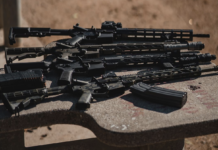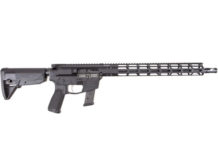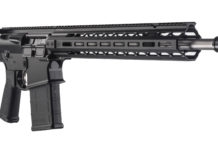On the range with Steve Coulston for a first impression of the Kel-Tec PLR-16 pistol.
Pistols that share the same calibers as rifles have gone in and out of popularity over the years. For folks that live in non-SBR friendly states or who would rather not go through the tedious ATF wait times, AR pistol have some appeal. My home state of Washington is not SBR friendly, so I have owned AR pistols and bullpups throughout the years to fill the SBR gap. There are even some training organizations that are advocates for them while other instructors will scoff and blow them off as range toys. Regardless of your opinion, rifle caliber pistols are part of the firearms landscape and are here to stay.
Over the weekend I was at the range participating in a photo shoot with some local SWAT. Our photographer, Crossfire, always has little gems tucked away in his trunk, buried under a mounds of gear and guns. So as we are getting ready, he rummages around, pushing aside ARs, plate carriers and bags, and pulls out a Kel-Tec PLR-16. Now, I must say I have not shot a ton of Kel-Tec products. I do have quite a bit of time behind the Kel-Tec KSG, but other than that my hands on exposure has been pretty minimal. That being said, I am familiar with their products, including the PLR-16.

For those of you who are not familiar, the PLR-16 is a polymer pistol made by Florida based Kel-Tec . The PLR-16 is not exactly an AR pistol, even though they both share the same 5.56/.223 chambering. The PLR-16 is 3.4 lbs unloaded and is 18.5 inches long with a 1:9 twist 9.2 inch barrel. Unlike the AR, it lacks the extension tube and buffer as its piston operating system doesn’t require it. There is the option to attach a forend with a Picatinny rail on the bottom in case you wanted to install a vertical foregrip, after you have been approved by the ATF to turn it into an AOW of course. There is a top Picatinny rail for your optics and it has a set of fixed iron sights with a 12.5 inch sight radius. The pistol takes standard AR mags and the mags are released in a similar manner by depressing the mag release button on the right hand side of the gun. The safety is a cross bar type and will show the color red when the safety is in the off position. The gun will also accommodate your typical aftermarket muzzle devices.
After looking the gun over for a few minutes, I was called away to do work on another project. I was wearing a leg rig on my left side so I took the unloaded PLR-16 and shoved it into the top of the rig, muzzle down with the mag well facing forward. Before anyone comments, about retention, and all that, it was stored in this manor strictly for convenience during the time we were standing around planning out the next shoot. It did grab a lot of attention, however. The SWAT guys working with us were all over it and were really interested in its compactness and caliber sizing. They had visions of running it for a back up CQC gun. Unfortunately, they didn’t have time to shoot it, so that will have to wait.
I on the other hand, did.

My first impression of the gun was it felt very light weight. At 3.4 lbs, it weighed less than half of the AR I had just been shooting. The PLR-16 I had did not have a rear sling adaptor, muzzle brake, optic or Picatinny forend. It was a stock gun with no bells or whistles. I found an empty spot on the range that put me about 7 yards to target. I used two mags during my time shooting it. Both were Gen III PMAGs. One was a 30 round and the other was a 40. I loaded the full 30 round mag into the magwell and charged the weapon. The method of charging is via a charging handle on the right hand side. This charging handle is reciprocating as it is attached to the bolt. My method of holding the pistol was with my firing hand on the pistol grip and my support hand on the magazine. It was a little chilly so I was wearing the outstanding Outdoor Reasearch Ironsight gloves, which didn’t impede the manipulation of the gun at all. I removed the cross bar safety and placed my first shots. At 7 yards my rounds hit where I pointed. Muzzle rise was significant and affected time back on target. I have no doubt the optional forend and an appropriate muzzle device would help in that regard.
After a few controlled rounds, I proceeded to empty the magazine as fast as I could… until the gun jammed. Rotating the gun to my left, gave me a good look into the ejection port. Double feed. After stripping the mag out and racking the charging handle a few times I tried to lock the bolt to the rear… but couldn’t find a way to do it. Turns out you can lock the bolt to the rear, but it is not that apparent. There is a button on the bottom of the gun behind the magwell when pressed up while the bolt is held to the rear will hold the bolt open. Without having that knowledge at the time I simply cleared the gun, inserted the 40 round PMAG, charged the gun and continued to put rounds down range. I also tried shooting the gun like a traditional pistol with my support hand directly in front of my firing hand. This approach work just fine and was not difficult to manage.
During my very limited time with the PLR-16 I only had time to put 70 rounds through the gun with the one malfunction. The gun was fun to shoot and I look forward to putting a can and a red dot on it just for kicks. I think a Midwest Industries aluminum railed handguard with a Magpul AFG would be in order too. As it lacks the extension tube it is really compact and can be carried under a coat fairly incognito. The polymer will not rust and can take a beating.

There are a few things AR shooters, like myself, will probably take issue with. First, there isn’t a way to swap out grips. In this day and age, variety is the spice of life. I want that option as I prefer a fuller and more aggressively textured grip. I suppose I could have this one stippled… Second, I don’t like cross bar safeties on pistol gripped semi-autos. I much prefer the traditional AR safety lever as it is more user-friendly and allows for fast safety on and off manipulation. The bolt lock was another issue. It is not intuitive for an AR shooter and felt clumsy. It would also be nice to have an integral QD sling attachment points on the both sides as well as the rear of the gun. The iron sites are pretty rudimentary as well. They work, but they sit really low and you will not be able to co-witness with your red dot of choice. I also would have like a larger magazine release button.
Ok, I get it, it is not an AR. If I want the AR features, I would go that route. That being said, it makes for a great weekend plinker and I bet it will attract the attention of some pistol hunters out there. If you are looking to purchase a Kel-Tec PLR-16, MSRP is $665.






[…] wrote a review on the Kel-Tec PLR-16 that highlighted its features and capabilities. The gun I received was stock. No bells. No […]
Hi Mark,
Thanks for your review of the PLR-16. Me and my son own one and we have never had a jam with either.
The other AR pistols are not really pistols, for they weigh twice as much and are much longer. The PLR-16 is light enough and short enough to carry concealed under a jacket easily. Also it is light enough to fire with accuracy with one hand ( in case other hand is not available).
It will penetrate better than a 44 mag and so is a very good self defense weapon against criminals with body armor. The use of AR mags is of course an obvious advantage.
I paid $399 for mine and that is another big advantage over the other AR pistols.
Thx Lou for the comments! I will be doing a follow up to this article as Kel-Tec sent us some upgrades for the PLR.
I’ll look forward to the future posts. My PLR has a standard muzzle break. I’ve ordered the Midwest rails for it. Still considering how to attach a single point sling.
Steve,
l bought a PLR-16 when they first came out. I’ve never had a jam with mine and no buffer tube was a big selling point for me. I can hit a 3″ diamond at 100 yds. With my Eotech site.(shooting off the bag) I’m very happy with my Kel-Tec, don’t sell it short.
Mark,
I am very glad it has been a good gun for you. Nice shooting! I always like to see products work like they should. I am by no means writing this gun off. These are just my first impressions of the PLR. Nothing more, nothing less. Thx for your comment. We always enjoy and welcome our readers comments!
Comments are closed.